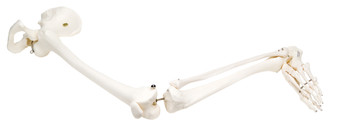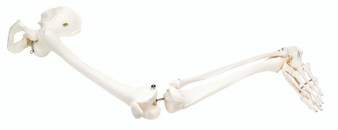Disarticulated Painted Full Skeleton
Unlock a new dimension of anatomical education with the “3B Scientific Painted Full Disarticulated Skeleton Model.” Tailored for those who seek in-depth knowledge of human anatomy, this meticulously crafted skeleton highlights muscle origins in red and insertions in blue, enhancing learning and retention. Ideal for medical students, professionals, and educational settings, this model boasts unmatched quality and an interactive Augmented Reality experience that elevates your anatomical proficiency.
Indications for Use:
- In-depth anatomical study
- Medical and health education
- Physiology training
- Anatomical demonstration
Profession/Settings Where Product is Used:
- Medical schools
- Universities and colleges
- Hospitals and clinics
- Private medical practices
- Laboratories
- Student - home study
Unique Features of the Product:
- Hand-painted muscle origins (red) and insertions (blue)
- Detachable skull for detailed study
- Digital twin access via Augmented Reality
- Quiz and drawing functions for enhanced learning
- Notes feature for personalized study
- Supports both male and female anatomical learning
- Multilingual support (11 languages)
Product Specifications:
- Weight: 19.14 lbs
- Height: 17.32 inches
- Width/Depth: 11.02 inches
- Length: 19.69 inches
- 53-piece skeleton with nylon-wired vertebral column
- Sturdy storage box included
Common Questions with Answers About the Product:
- Q: How does the Augmented Reality feature enhance the learning experience?
- A: The AR feature allows for interactive visualization, making learning immersive and engaging.
- Q: Are there any interactive quizzes available?
- A: Yes, the model includes an anatomy quiz function to test and improve your anatomical knowledge.
|
What do studies of using anatomical models in teaching and learning anatomy say? Reference: Adv Health Sci Educ Theory Pract. 2016 Oct;21(4):883-95. https://pubmed.ncbi.nlm.nih.gov/26459329/ The Effectiveness of Physical Models in Teaching Anatomy: A Meta-Analysis of Comparative Studies The meta-analytical results are: educational methods using physical models yielded significantly better results when compared to all other educational methods for the overall knowledge outcome (p < 0.001) and for spatial knowledge acquisition (p < 0.001). Significantly better results were also found with regard to the long-retention knowledge outcome (p < 0.01). No significance was found for the factual knowledge acquisition outcome. The evidence in the present systematic review was found to have high internal validity and at least an acceptable strength. In conclusion, physical anatomical models offer a promising tool for teaching gross anatomy in 3D representation due to their easy accessibility and educational effectiveness. Such models could be a practical tool to bring up the learners' level of gross anatomy knowledge at low cost. |











